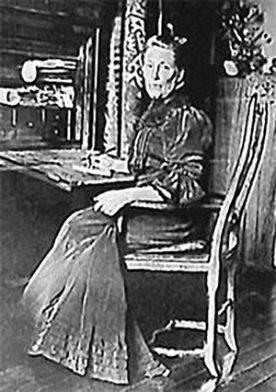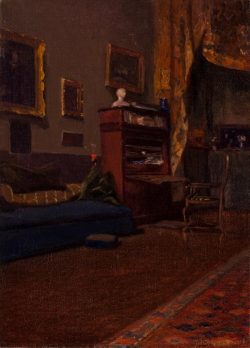Minvera Chapman in her Paris studio, circa 1906, from a photograph reproduced in Mary Jo McNamara and Elise Davis Chan, Minerva J. Chapman (1858-1947) (Potsdam, N.Y.: State University of New York College at Potsdam, 1997).

Minerva Chapman 1858–1947
Born in Sandbanks (now Altmar), New York, Minerva Josephine Chapman was brought to Chicago at a young age. Her father, a successful owner of tanneries and later first president of the First National Bank of Chicago, gave Chapman the financial independence to pursue a career in art as an unmarried woman. She attended the University of Chicago but graduated from Mount Holyoke College in Massachusetts, in 1876. In Chicago, Chapman studied art privately with Annie C. Shaw, the first woman to be elected to the Chicago Academy of Design. Chapman was among the first students to enroll in the Chicago Academy of Fine Arts (renamed the Art Institute of Chicago in 1882), where her most important teacher was John Vanderpoel. During her years there, Chapman made several trips east for additional study with various instructors.
In 1886, Chapman traveled to Europe, visiting Paris, Belgium, Holland, and Switzerland. She studied in Munich before attending the popular Académie Julian in Paris, but soon left to study privately with American painter Charles Lasar, with whom her friend Jessie Pixley Lacey also worked. Lasar was an influential teacher who championed women artists; he also encouraged them to paint landscapes en plein air in the manner of the French Impressionists, and he introduced Chapman to still-life painting. Returning to Chicago, Chapman exhibited with success at the Art Institute and with the newly formed Society of Western Artists. In 1900, just as miniature painting was enjoying a widespread revival, she began making the portrait miniatures that became an important facet of her work. Chapman was back in Paris in 1903, creating both oil paintings and miniatures in watercolor on ivory, a painstaking medium of which she became a recognized master. The Art Institute presented a solo exhibition of her miniature paintings in 1908. Chapman eventually completed nearly two hundred such works, including still-life images in miniature, and she also executed full-size portraits. Under the influence of French artist Emile René Ménard, with whom she studied privately, Chapman also took up the practice of making small, boldly brushed oil studies painted on site.
With the exception of the years during World War I, which she spent in San Diego and in the Chicago area, Chapman maintained a dual presence in Paris and in Chicago. In Paris, notwithstanding her expatriate status, she was typically noted in the American press as “Minerva Chapman of Chicago.” She exhibited in the Art Institute’s exhibitions for Chicago artists as well as its shows for American art and for watercolor painting, and with the Chicago Society of Miniature Painters; she was also regularly featured in the Paris Salon exhibitions and at many other national and international venues, and she won gold medals in the Panama-Pacific International Exposition in San Francisco in 1915 and the Panama-California exposition in San Diego in 1916. In Paris Chapman served as president of the International Art Union and, along with Mary Cassatt and Elizabeth Nourse, she was one of the first American women admitted to membership in the prestigious Société Nationale des Beaux-Arts. After Chapman left Paris to settle in Palo Alto, California, in 1925, she became active in local artists’ organizations, where she won several honors. Failing eyesight forced Chapman to give up painting in 1932, several years before her death at the age of eighty-eight. Since the early 1970s she has been the subject of several small exhibitions.
Wendy Greenhouse, PhD
